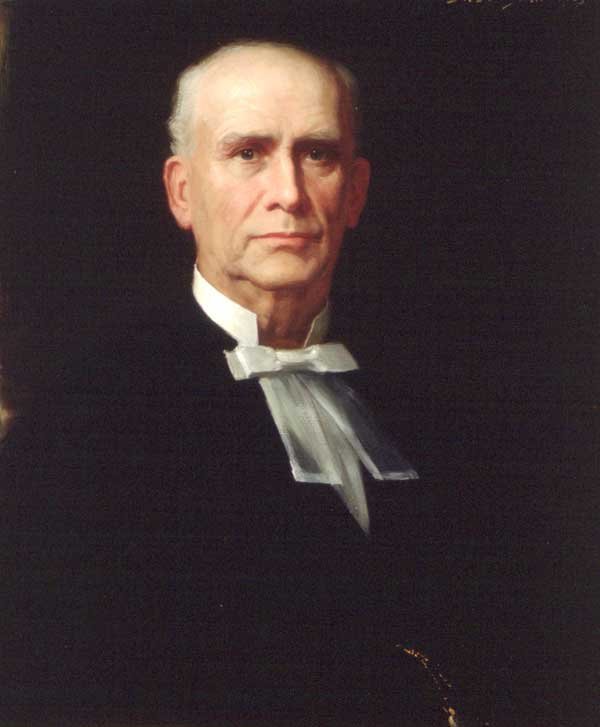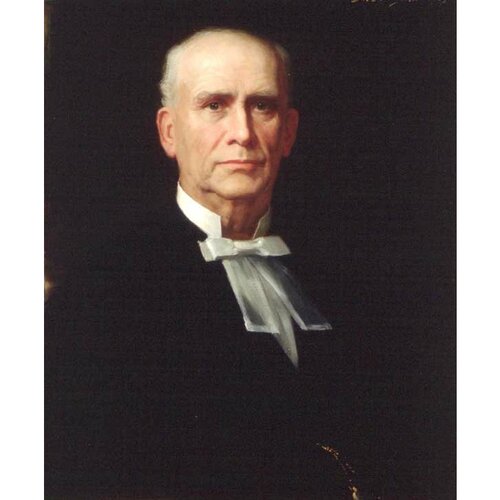
Source: Link
BALLANTYNE, THOMAS, teacher, politician, cheese manufacturer, and businessman; b. 13 Aug. 1829 in Peebles, Scotland, fourth son of James Ballantyne, a weaver, and Elizabeth Whitson; m. 24 April 1856 Mary Ballantyne (d. 1902), and they had seven sons and a daughter; d. 29 June 1908 in Stratford, Ont.
Thomas Ballantyne was an apprentice in his father’s shop in Peebles, but by 1850 he was working in a cooperative store at Innerleithen. Two years later his parents, along with Thomas and his sister, immigrated to Upper Canada and settled on the farm of their eldest son, in Downie Township, Perth County. In 1853 Thomas was hired to teach school in Downie and three years later he married a first cousin, daughter of the township’s reeve. A man of evident ambition, Ballantyne not only became known as a booster of education – he founded Downie’s first public library – but he also made the move into local politics, serving as auditor of Downie (1855, 1859–65), clerk (1856–57, 1865–66), and reeve (1867–68, 1870–73). In 1872 he was the only reeve from a southern township in Perth to vote on county council in favour of subsidizing the construction of a railway from Wiarton through Stratford to Port Dover. To farmers in the south, he had chosen the interests of Stratford over those of the countryside, and people in Blanshard and Fullarton townships were to remain suspicious of his motives throughout his political career.
It is impossible to say what first attracted Ballantyne to cheese making. He had quit his job as a schoolteacher in 1861 – probably over a salary dispute – and returned to farming. Likely he was already dairying, and this activity may have been what led him to visit the pioneer cheese factory which Harvey Farrington had recently opened in Oxford County. But the factory system was also taking the dairy industry by storm in 1866–67, with some 80 factories opening in the London district alone in that one year. Ballantyne was a tyrant by temperament and a cooperator by training, and cheese making suited him perfectly. After touring the birthplace of industrial cheese production in upstate New York, he founded a factory at a bend in the Black Creek near Sebringville. Black Creek was initially a cooperative factory where the farmers provided the capital, but cooperation soon gave way to sole proprietorship. In 1868 the price of cheese dropped suddenly and the industry briefly contracted. As the number of Black Creek’s patrons tumbled from 120 to 30, Ballantyne sold his farm and, with the help of a provincial grant, bought the factory outright. The business would remain under proprietary ownership until it was sold by his son in 1925.
Unlike most of the rural industries generated by the agricultural boom of the late 19th century, the production of cheese in factories was geared to foreign consumption. Almost all of the country’s factory output was exported, and well into the 20th century Canada would continue to have one of the lowest rates of cheese consumption in the western industrial world. And cheese was big business: by 1875 it was Canada’s third most valuable agricultural export and a decade later it ranked second. It is hardly surprising then that Ballantyne soon thought in terms of overseas distribution; in fact, his support in 1872 for a railway link had coincided with his opening of a warehouse in Stratford and his first selling trip to England. Success came quickly: one of his three-year-old cheddars won top marks from the international judges and the gold medal from the Canadian commission at the centennial exhibition in Philadelphia in 1876. By 1880, though virtually unavailable in Canada (it was served in a few expensive hotels), Black Creek coloured cheddar was one of the best-known and highest-priced North American cheeses sold in England.
Ever the proselytizer, Ballantyne was a vigorous promoter of the methods that made his cheese so successful. Black Creek was fortunate in having employed some of the country’s finest cheese makers and in having produced what, for the time, was a remarkably uniform product. Ballantyne the exporter wanted to ensure that everybody’s cheese measured up to the same high standards. He advanced his aims through the Canadian Dairymen’s Association (which he helped to found in 1867) and its successors, the Dairymen’s Association of Ontario and then the Dairymen’s Association of Western Ontario, formed in 1877. He served continuously as an executive member: director, 1867–91; president, 1872–73, 1879, 1882, 1886–87, and 1891; and honorary president, 1892–1908. A strong advocate of agricultural education, he was responsible for the establishment of the western Ontario association’s travelling instructor service and was instrumental in the creation of the Dairy School at Tavistock in 1891. Similarly worried about maintaining skills, he pressed for the unionization of cheese-factory employees and for the creation of an apprenticeship system. His factory was the first to use the Babcock test, by which milk was graded and purchased according to its butterfat content. In 1887 he had drafted the provincial legislation which made it illegal for farmers to skim cream off their milk and which authorized the association’s inspectors to enter farm buildings, test the milk, and charge farmers with stripping if the butterfat content was higher than that of the product they had delivered to the factory. Clearly, Ballantyne had a low opinion of dairy farmers; in fact, he seems to have regarded them as outworkers in need of managerial supervision.
A lifelong Grit, Ballantyne made his first bid for greater political prominence in the provincial election of 1871, when he ran unsuccessfully in Perth North. He was elected in 1875 in Perth South, and would hold this seat for the next 19 years. Though only briefly a farmer, he was widely regarded as an expert on rural matters and was considered a key farm representative in the Liberal government of Oliver Mowat. In 1891–94 he would serve as speaker of the Legislative Assembly.
The 1880s saw Ballantyne at the height of his influence. He had moved to Stratford around 1878, and devoted himself almost exclusively to politics and his mercantile interests. Ballantyne led the consortium of Stratford businessmen who bought out and reorganized the British Mortgage Loan Company in 1879 and he was a director of the Perth Mutual Fire Insurance Company. He maintained his interest in agriculture, but increasingly as an absentee investor. In the early 1880s he bought a farm, hired a manager, and went into business breeding Scottish Shorthorns and Ayrshires. He was an early advocate of industrial consolidation. By the end of the decade he had not only become a director of the Elma cheese factory and obtained controlling interest in the Tavistock Cheese Company, but he had also built two cold-storage warehouses in Stratford, formed the cheese-exporting firm of Thomas Ballantyne and Sons, and established a subsidiary business, Ballantyne Dairy Supplies, which, among other things, marketed his breeding stock. He had always worked on the fringes of farming, and his distance from the rural community grew as his wealth and status rose and as his associations with town society increased.
Ironically, in the 1880s Ballantyne was initially supportive of the growing farmers’ protest movement, led by the Grange and then by the Patrons of Industry [see George Weston Wrigley]. He accepted Grange criticism of factory practices and, as demanded by the Grange, in the early 1890s he began to issue production and financial reports to farmers delivering milk to his factory; he even bought shares in the Patrons’ cooperative binder-twine business in Brantford. Hence, the election results of 1894 were quite surprising. Ballantyne’s seat was considered safe – his connections to agriculture were thought to be unimpeachable. Nevertheless, despite the fact that moderate Conservatives supported him, he was defeated by John McNeill, a young farmer with no previous political experience. A Patron-endorsed Liberal, McNeill had been helped by his membership in the Protestant Protective Association [see D’Alton McCarthy*], but it was the support that Ballantyne had lost among the occupation-conscious farmers that made the difference. By the 1890s the farmers were increasingly rejecting the domination of local merchants, industrialists, and gentlemen farmers; even the Dairymen’s Association, once the mouthpiece of the cheese manufacturers, was being taken over by working dairy farmers. As was typical of many rural leaders, Ballantyne had dominated the farming community of his county from its urban-industrial periphery, and his declining influence at the end of the century was a symptom of the changes that were transforming rural society.
After his defeat, Ballantyne retired. His family, whose world had far outgrown Downie Township, continued to excel – Thomas and William as local businessmen, James as a professor at Knox College in Toronto, and Robert Mitchell as an executive in one of Britain’s largest wholesalers of dairy products. Ballantyne died in 1908, a cantankerous but highly respected merchant-industrialist. Three years before, in his will, he had estimated his fortune at $40,000.
AO, F 282. Stratford-Perth Arch. (Stratford, Ont.), Agriculture-Dairying-Downie Township file; Misc. 3/9 (Thomas Ballantyne papers). W. S. Dingman, “The Ballantynes,” Stratford Beacon-Herald, 29 April 1938. Evening Beacon (Stratford), 6, 15 June 1894; 31 Jan., 1, 8 Feb. 1895. Farmer’s Advocate and Home Magazine, 5 Sept. 1893, 9 July 1908. St. Mary’s Argus (St Marys, Ont.), 14 June 1894. Stratford Weekly Herald, 6 June 1894. G. H. Burn, “Cheese making” in “Dairy bulletin, by the Dairy School, Guelph,” Ontario Agricultural College, Bull. (Toronto), no.114 (1901). H. H. Dean, Canadian dairying (Toronto, 1903). Kathleen Finlay, Speakers of the Legislative Assembly of Ontario, 1867–1984 (Toronto, 1985), 32–34. The history of the Ballantyne family, ed. Mabel Erb Ballantyne ([Stratford], 1952). Illustrated historical atlas of the county of Perth, Ont. (Toronto, 1879; repr., ed. Ross Cumming, Port Elgin, Ont., 1972). William Johnston, History of the county of Perth from 1825 to 1902 (Stratford, 1903; repr. 1976). Ont., Commissioner of Agriculture and Arts, Report on the products, manufactures, etc., of Ontario, exhibited at the international exhibition, Philadelphia, 1876 (Toronto, 1877); Dept. of Agriculture, Annual report (Toronto), 1886–1900, reports of the Dairymen’s Assoc. of Western Ontario. Ontario agricultural commission, Report of the commissioners (4v., Toronto, 1881). J. W. Robertson, “Care of milk for cheese-making,” [Ontario] Agricultural College, Bull., no.28 (1888). J. A. Ruddick, “The development of the dairy industry in Canada,” The dairy industry in Canada, ed. H. A. Innis (Toronto, 1937), 15–123; “An historical and descriptive account of the dairying industry of Canada,” Can., Dept. of Agriculture, Dairy and cold storage commissioner’s branch, Bull. (Ottawa), no.28 (1911).
Cite This Article
David Monod, “BALLANTYNE, THOMAS,” in Dictionary of Canadian Biography, vol. 13, University of Toronto/Université Laval, 2003–, accessed January 1, 2025, https://www.biographi.ca/en/bio/ballantyne_thomas_13E.html.
The citation above shows the format for footnotes and endnotes according to the Chicago manual of style (16th edition). Information to be used in other citation formats:
| Permalink: | https://www.biographi.ca/en/bio/ballantyne_thomas_13E.html |
| Author of Article: | David Monod |
| Title of Article: | BALLANTYNE, THOMAS |
| Publication Name: | Dictionary of Canadian Biography, vol. 13 |
| Publisher: | University of Toronto/Université Laval |
| Year of publication: | 1994 |
| Year of revision: | 1994 |
| Access Date: | January 1, 2025 |



